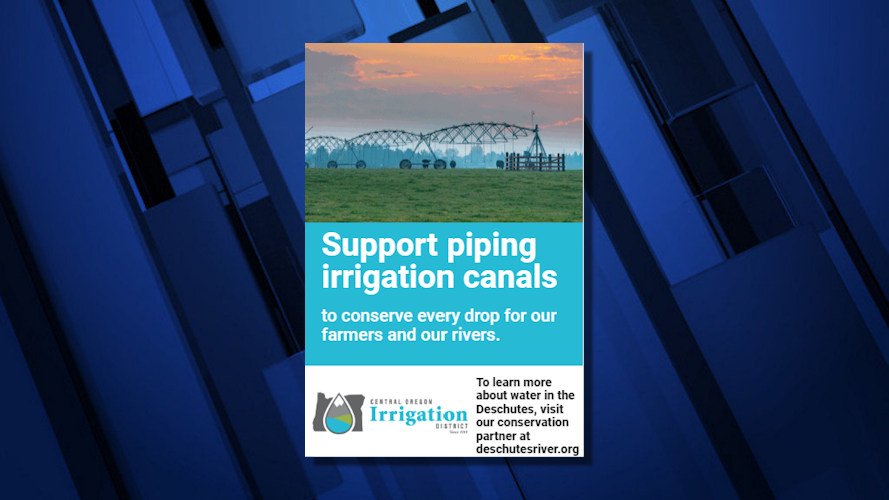Irrigation districts, Deschutes River Conservancy promote canal piping as key amid drought, farmers’ water crisis
Campaign launches ahead of federal approval process for 25-mile extension of piping Pilot Butte Canal
REDMOND, Ore. (KTVZ) - In a proactive step toward addressing the critical need for water conservation and infrastructure modernization, two of Oregon's largest irrigation districts, in partnership with the Deschutes River Conservancy, launched a public awareness campaign last week.
The initiative by the Central Oregon and North Unit irrigation districts is in partnership with the Deschutes River Conservancy, an environmental nonprofit dedicated to restoring streamflow and improving water quality in the Deschutes River Basin.
The campaign aims to raise awareness of the need to modernize aging, outdated and inefficient agriculture water delivery systems to support agriculture while ensuring critically needed instream flows are restored in the Upper Deschutes River.
Fine painted something of a dire picture of the future: "In 10 years, I mean, we have to have three times as much water. And with the drought, we've been cut to a quarter of our allotment, three-quarters of our allotment, half of our allotment this year. And so moving forward, it just compounds, because every year we're farming less and less."
Horrell said piping projects can help in a tough situation: "We have endangered species, we have farmers that are in need, and we have a (water) source."
A news release distributed by the partnership last week continues in full below:
With infrastructure dating over a century, the irrigation districts face significant challenges, with up to 50% of irrigation water lost due to leaky canals. Facing multi-year drought and the urgency to ensure more water stays in the Deschutes River, the districts are championing a plan to replace outdated open canal systems with closed pipes, ushering in a new era of efficiency and sustainability.
"The clock is ticking to meet the conservation measures outlined in the Deschutes Basin Habitat Conservation Plan," said Josh Bailey, manager of North Unit Irrigation District. "The viability of farmers in NUID is directly tied to the piping of COID. The sooner COID's Pilot Butte Canal project is complete, the sooner these farms will have the water security they require."
In addition to providing multiple benefits for COID irrigators including increased water reliability, operational efficiencies, and opportunities for pressurized water, there is a direct and significant benefit to North Unit farmers, who are junior water right holders.
COID's conservation measures will generate a more reliable water supply for NUID patrons in Jefferson County. The district will then be able to make water available from their storage in Wickiup Reservoir to increase winter flows in the Upper Deschutes River, benefitting the Deschutes River and the agriculture community.

COID completed Phase 1 of the Pilot Butte Canal Piping project in 2022 and delivered 21 cubic feet per second (cfs) of conserved water through its pipe to NUID. One hundred percent of the water conserved through the first phase of the 7.9-mile piping project between Redmond and Smith Rock is being used to address flow imbalances in the Upper Deschutes to address the habitat requirements associated with the Oregon Spotted Frog.
COID's water infrastructure modernization efforts have already proven themselves with farms like Smith Rock Ranch, home to Central Oregon's largest pumpkin patch.
"After COID finished the first phase of the Pilot Butte Canal Piping project, I was able to upgrade my systems. I've already seen water conserved on my property and a huge savings in our energy bill. As the irrigation districts pipe further upstream, and more farmers participate in conserving water, the amount of water for our farms and wildlife will only multiply," said Matt Lisignoli owner of Smith Rock Ranch.
Serving 4,600 irrigators across 101,000 acres, COID and NUID's joint effort is crucial for ensuring water reliability and operational efficiencies. COID's Phase 1 delivery of conserved water to NUID demonstrates significant water savings, equivalent to filling an Olympic swimming pool every ten minutes during the irrigation season. The fully piped system will provide gravitational pressure, reducing irrigation pump usage by 90% and saving energy equivalent to 2.6 million gallons of gasoline.
"We are using every tool available to conserve and deliver water including water marketing, on-farm and past the point of delivery conservation projects, and piping open canals," said Craig Horrell, managing director of Central Oregon Irrigation District. "Our goal has always been to help our neighboring farmers, increase winter flows in the Deschutes, and enhance Oregon spotted frog habitat to meet the Deschutes Basin Habitat Conservation Plan."
COID, in partnership with the U.S. Department of Agriculture Natural Resources Conservation Service, proposes a continuation of its modernization of the main stem of Pilot Butte Canal. The project extends approximately 25 miles from existing improvements in Redmond to the diversion point in Bend, with the aim of conserving 13 billion gallons of water annually.
To evaluate the potential environmental impacts associated with these enhancements, NRCS will prepare an Environmental Impact Statement (EIS) in accordance with the requirements of the National Environmental Policy Act (NEPA).
The project began in the fall of 2021 and incorporates several public comment periods, affording stakeholders opportunities to review the proposed plan and offer input. The release of the draft Environmental Impact Statement is anticipated this summer.
"This collaborative partnership between the irrigation districts supports agriculture while ensuring critically needed instream flows are restored in the Upper Deschutes River to benefit the Oregon spotted frog and native redband trout," said Kate Fitzpatrick, executive director of the Deschutes River Conservancy. "We actively support this large-scale conservation, and we are working with the districts on smaller-scale and on-farm conservation measures, as well as market-based approaches to reach streamflow goals as quickly as possible."
As part of the campaign, public service announcements will run on TV, social media, and other online platforms. Community members are encouraged to visit the Deschutes River Conservancy's website at deschutesriver.org and take action by writing letters of support and signing up to support irrigation modernization.
View Documentary Piping Solutions: A Lifeline for Central Oregon Farms & Deschutes River
[TV Spot] Piping Solutions: A Lifeline for Farmers & the Deschutes River
###
About Central Oregon Irrigation District
Established in 1918, Central Oregon Irrigation Distt (COID) is a pioneering organization dedicated to managing and distributing irrigation water in Central Oregon. Operating as a Municipal Corporation within the State of Oregon, COID is dedicated to providing a reliable supply of water to 3,500 patrons across approximately 46,222 acres of productive land in Bend, Redmond, Powell Butte, and Alfalfa. COID actively engages in water conservation, drought resilience, and environmental enhancement by embracing a forward-thinking approach. Notably, COID has increased stream flows in the Deschutes Basin by 133.57 cfs since 2000, achieved through innovative water conservation projects and permanent instream transfers. coid.org.
About North Unit Irrigation District
North Unit Irrigation District (NUID) is a key player in Oregon's agricultural sector, dedicated to providing reliable water resources to farmers in the Deschutes Basin. Serving [insert number] irrigators across [insert number] acres, NUID is committed to sustainable water management and collaborates with stakeholders to address challenges such as water conservation and habitat restoration. Through innovation and modernization, NUID aims to enhance water efficiency and support the agricultural community while preserving the health of the Deschutes River and endangered species in the region. www.northunitid.com.
About the Deschutes River Conservancy
The Deschutes River Conservancy (DRC) was formed in 1996 with a mission to restore streamflow and improve water quality in the Deschutes River Basin. The DRC has a multi-stakeholder board and, through collaborative efforts, has restored up to 350 CFS (equivalent to over 14 Olympic-sized swimming pools per hour) of flow in the basin with non-litigious, voluntary, and market-based programs. For more information about the DRC, visit www.deschutesriver.org.




